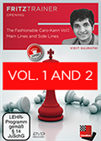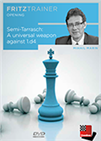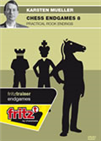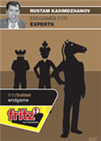Radjabov ½-½ Carlsen
A draw after 19 moves and a playing time of 25 minutes. What can I say? Just see what the players had to say for themselves.
Magnus Carlsen was by no means enthusiastic about his previous draws, but that did not mean he was in a very combative mood today. Yesterday he played the double-edged Modern system (1...g6) against Rauf Mamedov and gained some advantage. Recently, he also experimented with the King's Indian Defence at the Grenke Chess Classic. Against Radjabov, one of the specialists of this opening, Carlsen preferred to rely on the solid semi-Slav, an opening on which his trainer and second has published a DVD. He knew about the possibility of a repetition in this particular variation, which both players claim can't be avoided in the final position.
The Semi-Slav (1.d4 d5 2.c4 c6 3.Nf3 Nf6 4.Nc3 e6) can arise via various move orders, has decided World Championships, and is one of Black's most fascinating replies to 1 d4. Magnus Carlsen's second, Grandmaster Peter Heine Nielsen explains in detail what this opening is all about.

Carlsen doesn't see his slow start as too tragic | Photo: Shamkirchess.az
Not a great start to the tournament, but no drama, is Carlsen's conclusion. "We're both in the lead, what's not to like?" he laughed. (Of course, that was about to change!)
Teimour Radjabov was forced to provide a good justification for the short draw. After all, he plays in front of home crowd and also had the white pieces. He cited strategic reasons for the short draw. He had checked his games against Magnus and came to the conclusion that he had always tried with "to play" [for advantage] with white in the past, but it only got him into trouble. With the black pieces he also has not had much fun, but at least he scored a point every now and then. So he came to the conclusion that, currently, the best way for him to play is super-solidly against Magnus. It has been over three years since their last meeting at classical time controls — Tata Steel Chess 2015 — which Carlsen won, although Radjabov did win their World Blitz Championship meeting in October 2015. Since then they have played just one more blitz game, in Doha 2016, which Carlsen won.
Radjabov then talked about the importance of Elo and that this is the only market value of a player in the end. He had entertained the audience well with his KID forays for years, but ultimately it's about which places you end up in the top class events. "You entertain the audience and in the end receive no invitations" — unfortunately, this is the reality. Therefore, he was satisfied with a short draw against Magnus, audience or no audience.

Radjabov has been short on invitations lately | Photo: Official site
Karjakin ½-½ Navara
Navara's Caro-Kann got another test from the other participant in the last World Championship — and he passed with flying colours! A theoretically highly relevant game in a principal variation.
 The Caro Kann is a very tricky opening. Black’s play is based on controlling and fighting for key light squares. It is a line which was very fashionable in late 90s and early 2000s due to the successes of greats like Karpov, Anand, Dreev etc. Recently due to strong engines lot of key developments have been made and some new lines have been introduced, while others have been refuted altogether. I have analyzed the new trends carefully and found some new ideas for Black.
The Caro Kann is a very tricky opening. Black’s play is based on controlling and fighting for key light squares. It is a line which was very fashionable in late 90s and early 2000s due to the successes of greats like Karpov, Anand, Dreev etc. Recently due to strong engines lot of key developments have been made and some new lines have been introduced, while others have been refuted altogether. I have analyzed the new trends carefully and found some new ideas for Black.
Anish Giri watches David Navaras Caro Kann — in round 6 the Dutchman can try it himself | Photo: Shamkirchess.az
Wojtaszek ½-½ Mamedov
Radoslaw Wojtaszek is a well-versed connoisseur of opening theory and the creator of many a novelty for Vishy Anand, with whom he worked for many years as a second. Rauf Mamedov chose a rare line in the Tarrasch variation of the Queen's Gambit. This was long considered Kasparov's hobbyhorse, but today interest at the professional level has fallen off sharply. Black receives an isolated d-pawn, hoping in return for dynamic piece play.
After 15 moves Mamedov could already be satisfied. Although he has a second weakness on b6, it's covered by 15...Ra6. The more important question in this type of position revolves around the d4 square. If White manages to control and block it, then d5 becomes a weakness in the medium term and the e6-bishop is condemned to passivity. However, if Black manages to advance ... d4, the pawn on e2 is often weaker than the outpost on d4, also black can use the d5-square as well. In the concrete position, it is already clear: Black will get in ...d4 and have good prospects.
 Even though the Semi-Tarrasch cannot offer a complete repertoire against 1.d4, being conditioned of White’s move order, it is an excellent complement to the Nimzoindian Defence. Throughout history, great players like Fischer, Kortschnoj and Kramnik have included the Semi-Tarrasch in their repertoire which strongly speaks about its safe character and Black’s possibilities for counterplay. GM Mihail Marin presents a complete Semi-Tarrasch repertoire for Black, explaining the main strategic ideas of the resulting structures.
Even though the Semi-Tarrasch cannot offer a complete repertoire against 1.d4, being conditioned of White’s move order, it is an excellent complement to the Nimzoindian Defence. Throughout history, great players like Fischer, Kortschnoj and Kramnik have included the Semi-Tarrasch in their repertoire which strongly speaks about its safe character and Black’s possibilities for counterplay. GM Mihail Marin presents a complete Semi-Tarrasch repertoire for Black, explaining the main strategic ideas of the resulting structures.
Rauf Mamedov | Photo: Shamkirchess.az
 Rook endings are amongst the most frequently encountered endgames there are, and so your training effort will be quickly repaid in the form of half and full points. Knowing even a few rules of thumb and key methods makes life a great deal easier and provides a guiding light even in complex positions. This DVD focuses on the important themes which are to be found in common rook endings.
Rook endings are amongst the most frequently encountered endgames there are, and so your training effort will be quickly repaid in the form of half and full points. Knowing even a few rules of thumb and key methods makes life a great deal easier and provides a guiding light even in complex positions. This DVD focuses on the important themes which are to be found in common rook endings.As a result, Mamedov could play against the weak pawns on a2 and e2 and, with an interesting exchange sacrifice, brought Wojtaszek to the brink of defeat. "Rado" finally saved himself in a pawn-down rook ending.
With this pawn structure on the kingside, White can draw without much trouble.
Topalov 1-0 Mamedyarov
An exciting encounter with a happy ending for Veselin Topalov. Both players played razor sharp, although Mamedyarov criticized his game afterwards as "too risky". For a long time, one had the impression that the local hero had everything under control, but Topalov's bishop turned out to be stronger than Mamedyarov's pawn. Equally entertaining was the press conference afterwards — the opinions of the opponents were so different at every turn.

A setback for the top Azerbaijani player | Photo: Shamkirchess.az
Giri ½-½ Ding
The duel of the draw kings, one can confidently call the meeting of these two players. Giri's penchant for draws is well-known — he pokes fun at it himself — and Ding was considered Giri's heir after his eleven consecutive draws at the Candidates Tournament in Berlin. Both players should, therefore, feel at home in Shamkir. After all, in the first three rounds, not a single game had a winner. After 47 moves of heavy fighting in the middlegame, there was a queen ending on the board, which ended turned into a bishop endgame. Giri had to sacrifice his bishop for a black pawn but, due to the reduced material, retained good drawing chances.
 If you want to play successful chess you must pay great attention to the endgame. On this DVD, Rustam Kasimdzhanov analyses the type of practical endgames which tournament players encounter on a daily basis. He explains what has to be known in order to make the correct strategic decisions and to find the correct plan in such endings. Kasimdzhanov’s outstanding and easily understandable explanations will certainly help you to substantially improve your own performance in the endgame.
If you want to play successful chess you must pay great attention to the endgame. On this DVD, Rustam Kasimdzhanov analyses the type of practical endgames which tournament players encounter on a daily basis. He explains what has to be known in order to make the correct strategic decisions and to find the correct plan in such endings. Kasimdzhanov’s outstanding and easily understandable explanations will certainly help you to substantially improve your own performance in the endgame.
Giri holds half the point | Photo: Shamkirchess.az
Standings after four rounds
Games of the round
Translation from German: Macauley Peterson
Links
























